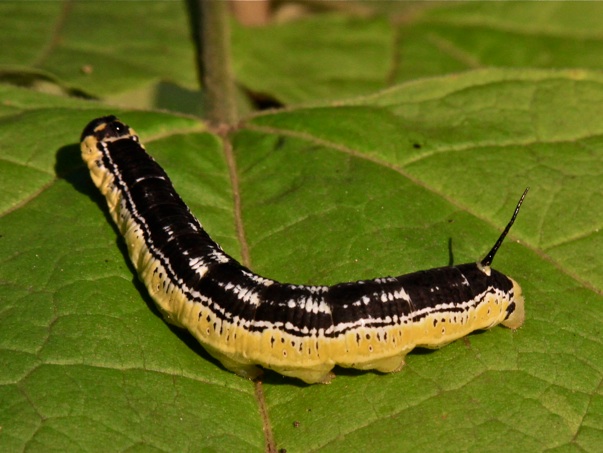The Nature
Observer’s Journal
The Nature
Observer’s Journal

Tobies:
The Cigar Tree
Chuck Tague
I grew up in western Pennsylvania. Consequently, I had to unlearn much nature lore. Cabbage moths are butterflies, lightning bugs are beetles, buckeyes are Horse Chestnuts and jaggers are not a species but any plant with spines, thorns or prickles. Mike Lustri, who also grew up around Pittsburgh, asked me about another of our regional specialties, the “Toby Tree”. He specifically was curious about the origin of the name.
Toby Trees are one of two species of Catalpas. The Southern Catalpa, Catalpa bignonioides, is native to the southeastern United States; Northern Catalpa, Catalpa speciosa, to the southern midwest. Both adapt well to northern climates and have been widely planted for shade and as street trees. I passed many on my daily walks to school. Southern Catalpa also grows wild along roadsides and in disturbed areas around Pittsburgh. It has whorls of huge heart-shaped leaves and large, showy blossoms in spring.

When the leaves drop in October long, cylindrical seed capsules droop from the branches. This is the feature most Pittsburghers remember. The capsules can be over twenty inches long. They resemble cigars and most references list Cigar Tree or Indian Cigar Tree as alternative names. It was common knowledge to every school-age boy around Pittsburgh that tobies can be dried and smoked. Many of us tried it swore toby cigars were pretty good.

I’ve checked all my tree references. None mention Toby Tree as a common name. All references to Toby Trees were in reminiscences of a Pennsylvania childhood. It is a Pittsburgh thing. Nor do the botanical references mention smoking as one of catalpa’s historical uses. On the herbal remedy websites I found this cautionary citation several times:
Bignonia catalpa is considered by some to be an herbal remedy. It's used as a sedative, a narcotic or an antiasthmatic. The bark and the fruit are used in herbal preparations. It has highly poisonous roots.
We weren’t the only kids that smoked catalpa seed capsules. In the south older kids would convince gullible youngsters that Cigar Trees grew cigars and encourage them to light up. OF course their victims got violently ill. Could it be that generations of Pittsburgh city kids were duped by our rural neighbors?
As far as the name Toby Tree, I can only speculate. “Toby” could be a word for cigar in one of the many languages spoken by those who immigrated to work in Pittsburgh’s mills. Possibly it’s a corruption of “stogie”. “Stogie”, a tubular, non-tapered cigar, is derived from “Conestoga” and refers to a smoke favored by wagon drivers from Lancaster, PA.
Besides a street shade tree, catalpas have another important use in the south. Fishermen maintain them as a source of Catalpa worms. These are the larval form of the Catalpa Sphinx Moth, Ceratomia catalpae.

Sphinx moths are named for a defensive posture of its larva that is reminiscent of the Egyptian Sphinx monuments. The Catalpa Sphinx, or Catalpa Worm, is a large black and yellow caterpillar that feeds exclusively on catalpa leaves and can defoliate host trees. Southerners know the catalpa worm as a garden pest, but they are also aware that fish find it irresistible. References to their use as bait date back at least to the 1870's.
Catalpa Sphinx caterpillars have a distinctive black "horn" on the end of their abdomen. Mature caterpillars are pale yellow with black heads and a broad black stripe running the length of their back. Some have black spots or vertical bands on their sides. They grow and shed their skin five times until they become stout-bodied and four inches long. They then transform to a cocoon-less pupa, descend the tree and burrow two to three inches into the soil. The following May they emerge as adults. They mate and lay clusters of up to a thousand eggs on the underside of fresh catalpa leaves. Eggs usually hatch in five to seven days.

The Nature Vocabulary of Pittsburgh
1Sputzy: Pittsburgh for the ubiquitous House Sparrow, Passer domesticus.
2Buckeye: the seeds of the European Horsechestnut, Aeschulus hippocastanum.
3Monkeyball: the large, warty, lime-green grapefruit-sized aggregate fruit of the Osage Orange tree, Maclura pomifera.
Jaggers, Cabbage Moths, and lightning bugs -- any others?
From Mike Lustri: Chuck, can you share with us the origin of the term "Toby tree?" It is a tree indigenous to Western Pennsylvania. When I lived in Oakmont, we would smoke the "toby's" around this time of the year.
Monday, September 19, 2011
